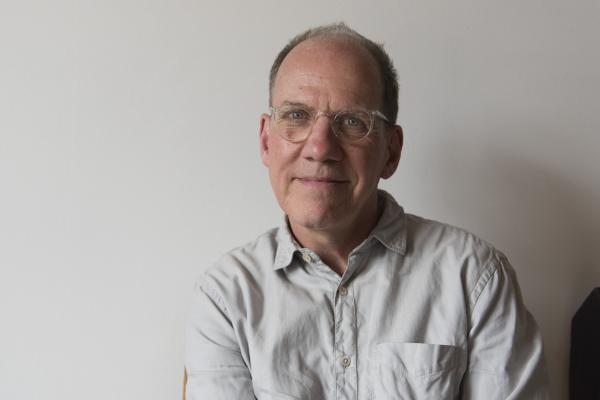BETHA-funded <i>Wind|Farm</i> to take shape on Oval

Last spring, Michael Mercil, professor, art, was awarded a 2016 Battelle Engineering, Technology and Human Affairs (BETHA) Endowment annual grant. BETHA grants support projects that examine the complex relationship between science and technology on society and cultural issues. Mercil's project, Wind|Farm, is an experimental artwork on campus. We asked him a few questions about the project, which will start taking shape this fall.
Tell us a little bit about your BETHA-funded Wind|Farm project.
Wind|Farm is a proposed 500-square-foot energy park located, temporarily, outside the Wexner Center for the Arts and near the Oval. Its centerpiece includes a 70-foot-tall, sparkling-gold wind turbine that produces electricity used, ideally, to support Wexner Center and other creative activities at Ohio State. The project culminates a trio of my Living Culture Initiative artworks here, including The Beanfield (2006-08) and The Virtual Pasture (2009-11).
What is your goal with Wind|Farm?
My goal is to visibly manifest a variety of cultural and scientific issues critical to developing an ecologically resilient and sustainable energy future. Through its distinctly non-traditional approach to its subject, Wind|Farm engages the objective of the Battelle Endowment to examine our “understanding of the impact of science and technology on individuals and society” by:
- Directly harnessing green technology to the distribution of contemporary cultural production
- Restoring native plant conditions as a live example of carbon sequestration
- Embodying in unique ways the founding mission of Ohio State as a public institution of higher learning in the “agricultural, mechanical and liberal arts”
What is the project’s relevant message regarding the environment and sustainable energy?
Aside from generating usable electric current, Wind|Farm takes up the task of making rapid ecologic and environmental change a tangible aspect of everyday campus life. Simultaneously, it publicly articulates and challenges the aspirational goal of the College of Arts and Sciences as “the university’s primary laboratory for inquiry into human expression; social and cultural systems; and physical, biological and cognitive processes — that is, defining what it is to be human and our relationship with the universe through learning, discovery and engagement.” (from the College Arts and Sciences 2011 Strategic Plan)
How will this extremely visible installation engage students and the campus community?
As one among a sequence of Living Culture projects, Wind|Farm demonstrates my commitment to activating a variety of community in-reach as well as community out-reach projects and programs. These include working closely together with Shelly Casto, director of Wexner Center Education and its Art & Environment classes for Columbus high school students. My partnership with the campus as a Living Lab (CALL) program provides opportunity for engaging directly with Ohio State students, faculty and staff. Likewise, my ongoing collaborations with the Department of Art; the College of Food, Agriculture and Environmental Sciences; and with Energy Services and Sustainability for Facilities, Operations and Development, all provide important sources of technical and programmatic support.
What role does art, particularly public art, have in addressing ecological and environmental issues?
All art reflects or manifests the circumstance of its making. In a period of scientifically measurable and globally manifest climate change, public art potentially grounds our awareness of the consequence of human interaction with the biosphere in an arena open equally to aesthetic consideration and comprehensible, meaningful, civic debate.
This is the capstone of three projects that are part of your Living Culture initiative at the same site. What is their collective message?
Through direct student, faculty and public engagement these Living Culture Initiative projects create a public forum to address the question: If this university is not only a place for cultural reflection, but is likewise a site for cultural production, then what is the nature of the culture we produce here?
